
Kyiv-Pechersk Lavra or Kyievo-Pecherska Lavra, also known as the Kyiv Monastery of the Caves, is a historic Eastern Orthodox Christian monastery which gave its name to one of the city districts where it is located in Kyiv.
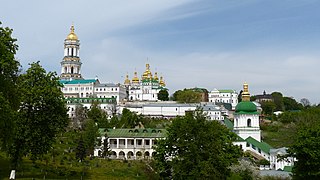
Kyiv is the capital and most populous city of Ukraine. It is in north-central Ukraine along the Dnieper River. As of 1 January 2022, its population was 2,952,301, making Kyiv the seventh-most populous city in Europe. Kyiv is an important industrial, scientific, educational, and cultural center in Eastern Europe. It is home to many high-tech industries, higher education institutions, and historical landmarks. The city has an extensive system of public transport and infrastructure, including the Kyiv Metro.

Saint Sophia Cathedral in Kyiv, Ukraine, is an architectural monument of Kievan Rus'. The former cathedral is one of the city's best known landmarks and the first heritage site in Ukraine to be inscribed on the World Heritage List along with the Kyiv Cave Monastery complex. Aside from its main building, the cathedral includes an ensemble of supporting structures such as a bell tower and the House of Metropolitan. In 2011 the historic site was reassigned from the jurisdiction of the Ministry of Regional Development of Ukraine to the Ministry of Culture of Ukraine. One of the reasons for the move was that both Saint Sophia Cathedral and Kyiv Pechersk Lavra are recognized by the UNESCO World Heritage Program as one complex, while in Ukraine the two were governed by different government entities. The cathedral is a museum.

The Church of the Tithes or Church of the Dormition of the Virgin was the first stone church in Kyiv. Originally it was built by the order of Grand Prince Vladimir (Volodymyr) the Great between 989 and 996 by Byzantine and local workers at the site of death of martyrs Theodor the Varangian and his son Johann. It was originally named the "Church of Our Lady", in honor of the Dormition of the Theotokos. The church was ruined in 1240 during the siege of Kyiv by Mongol armies of Batu Khan.
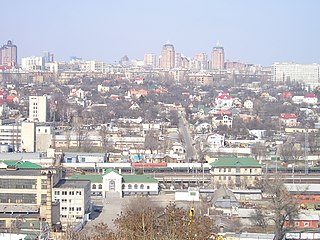
Pecherskyi District is an urban district of Kyiv, the capital of Ukraine. It lies within the eponymous historical neighborhood, while also including some other historical areas. The Pechersk neighborhood is located on the hills adjoining the right bank of the Dnieper. These two geographical entities are often confused with each other. The Pecherskyi District can be considered to be the very heart of Ukraine.
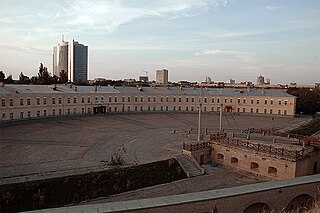
The Kyiv Fortress or Kiev Fortress is a historical and architectural monument complex of fortifications in Kyiv, Ukraine built from the 17th through 19th centuries. Construction began after the 1654 Council in Pereiaslav, on the site of the already existing fortified monastery of Kyiv Pechersk Lavra. Located on the hills of the high right bank of the Dnieper, bounded on the north by the Klovsky ravine, on the south and west – by the slopes of the Lybid River valley.

St Volodymyr's Cathedral is a cathedral in the centre of Kyiv, and one of the city's major landmarks. Since the unification council of the Eastern Orthodox churches of Ukraine in December 2018, it has been under the ecclesiastical jurisdiction of the Orthodox Church of Ukraine. Before that, it was the mother church of the Ukrainian Orthodox Church – Kyiv Patriarchate.

Vydubychi Monastery is a historic monastery in the Ukrainian capital Kyiv. During the Soviet period it housed the NANU Institute of Archaeology.

The Holy Dormition Pochaiv Lavra, also sometimes known as the Pochaiv Monastery, is a monastery and lavra in Pochaiv, Kremenets Raion, Ternopil Oblast, Ukraine. The monastery tops a 60-metre hill in the town of Pochaiv, 18 km southwest of Kremenets and 70 km north of Ternopil.

St. Michael's Golden-Domed Monastery is a monastery in Kyiv, the capital of Ukraine, dedicated to Saint Michael the Archangel. It is located on the edge of the bank of the Dnipro river, to the northeast of the St Sophia Cathedral. The site is in the historical administrative neighbourhood of Uppertown and overlooks Podil, the city's historical commercial and merchant quarter. The monastery has been the headquarters of the Orthodox Church of Ukraine since December 2018.
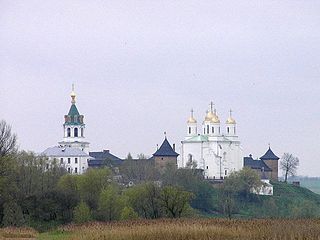
The Assumption Monastery at the Holy Mountain is a stauropegial Ukrainian Orthodox cave monastery belonging to the Ukrainian Orthodox Church. It is located at the top of the Holy Mountain rising above the Luha River near the village of Zymne. It is five kilometers south of Volodymyr, Volyn Oblast, Ukraine.

The Near Caves or the Caves of Saint Anthony are historic caves and a network of tunnels of the medieval cave monastery of Kyiv Pechersk Lavra in Kyiv, the capital of Ukraine. The Near Caves have a total length of 383 metres and are 5 to 20 metres deep.

The Refectory Church is a building composed of a refectory and an adjoining church of Saint Anthony and Theodosius of the medieval cave monastery of Kyiv Pechersk Lavra in Kyiv, the capital of Ukraine. In the refectory, the Lavra monks had their meals. The building was constructed in 1893–1895 at a time when more than a thousand monks were living within the monastery. The new refectory replaced a previous that existed since 17th century.

The Gate Church of the Trinity is a historic church of the cave monastery of the Kyiv Pechersk Lavra in Kyiv, the capital of Ukraine. Originally being built as in the church style of Kievan Rus', the Gate Church of the Trinity is now decorated in the Ukrainian Baroque style, having been reconstructed many times through its history.
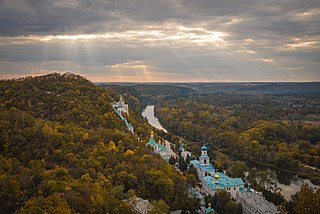
The Holy Mountains Lavra of the Holy Dormition is a major Orthodox Christian monastery on the steep right bank of the Siverskyi Donets River. The name comes from the surrounding Holy Mountains; the Holy Dormition is another term for the death of the Virgin Mary.
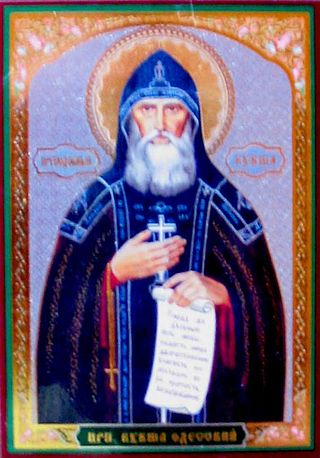
Kuksha of Odessa, born Kuzma Kirillovich Velichko, was an imperial Russian priest and a Ukrainian Orthodox Church saint who was canonized in 1995.

Pechersky Ascension Monastery is a monastery in Nizhny Novgorod, Russia. It is the principal monastery of the Nizhny Novgorod Eparchy (diocese) and the seat of the Bishop of Nizhny Novgorod and Arzamas.

The Kiev Theological Academy (1819—1919) was one of the oldest higher educational institution of the Russian Orthodox Church, situated in Kiev, then in the Russian Empire. It was considered as the most senior one among similar academies in Moscow, Saint Petersburg, and Kazan. It was located at the Kiev Podol within the Kiev Epiphany Monastery. In the Russian historiography, the Academy′s predecessor was the Academia Mohileana that was founded earlier in the 17th century.
Icon-painting School of the Kyiv Pechersk Lavra has long been the center of Kievan Rus and Ukrainian painting. It was founded by Alipy Pechersky at the beginning of the 12th century.

Stepan Demianovych Kovnir was a Ukrainian builder and master mason in Kyiv. His nearly sixty years of labor brought aesthetic unity to the ancient, sprawling center of Ukrainian culture and education, the Kyiv Pechersk Lavra, which is now a UNESCO World Heritage Site. A serf without any formal education, he became an early master of Ukrainian baroque architecture as well as organizing a school for masons.





























